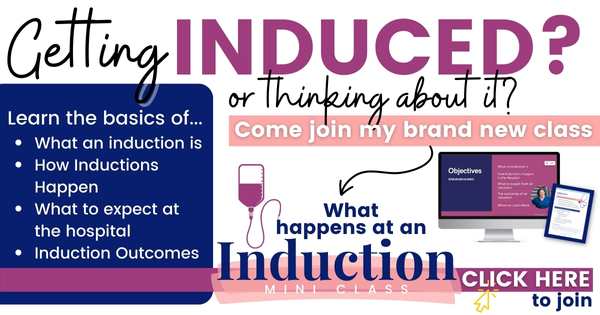Getting induced is a decision that many women make. 23% of women (probably on the low side of the actual number) are induced. Why would a would need or want to be induced? As a labor nurse we will talk about the top 5 reasons for induction.

First off, hello! I’m Hilary — many people know me as The Pregnancy Nurse 👩⚕️. I have been a nurse since 1997 and I have 20 years of OB nursing experience, I am also the curly head behind this website Pulling Curls and The Online Prenatal Class for Couples. 🩺 I have seen thousands of inductions, and talked to many patients and providers about WHY they are being induced.
If you’re looking to get induced — be SURE to grab my induction question checklist:
Before we get into it — I want to say that as a labor nurse I am a HUGE fan of letting mother nature take her course, and allowing your baby to be born on their own timeline as much as possible (even if that means going overdue). A lot of people believe that doctors push inductions, and I actually believe more patients want them than doctors push them.
That being said, there are a lot of reasons we shouldn’t wait for mother nature, so let’s talk about them (be sure to check out my Pregnancy Nurse post on being induced at 37 weeks). I also have a whole post on if you can ask to be induced at 37 weeks.
Reasons to Induce Labor in Pregnant Women
Today I want to share 5 reasons why a pregnant woman might be induced. I go into the vast majority of reasons why women get induced in my labor course, but I think this will give you a good idea (and will also help you translate into whatever condition you’re facing). BTW if you’re likely getting induced check out my easy ways to prepare for an induction.
** Of COURSE there are LOTS of medical conditions that require an induction, but I am speaking to the most common ones.
Fun fact: Pain is not normally a reason for an induction.
Large Baby (Large for Gestational Age)
If your baby is measuring large, they may make the choice to induce you.
They can measure the baby in a couple in a few ways:
- Measuring tape (your provider measures from the top of your pubic bone to the top of your uterus)
- Leopold’s Maneuvers (your provider will feel where the baby’s head and limbs are in in your uterus with his/her hands)
- Ultrasound — keep in mind that earlier ultrasounds are more accurate on baby’s weight, as there is more baby to measure the further along you get. I did a recent podcast on ultrasound testing:
Those measurements, possibly in combination with a vaginal exam to determine how large your baby exit area is (depending on the angle and positioning of your pelvic bones) will help them determine if an induction is appropriate.
There are some potential risks to a large baby, but the main one is that they won’t fit through your pelvis. However, this might not be your best option, so be sure to discuss it with your provider. If this is the case they are trying for you to have a vaginal delivery vs a caesarean section.
Diabetes (including Type 1, Type 2 or gestational Diabetes)
Due to the sugar in your system sometimes diabetes grows a larger baby.
In fact, if you fail your 1 hour glucose test, it can also mean that you could have a larger baby as well.
All of this then reverts back to the large baby paragraphs above. It depends on how well your glucose is controlled, and a number of factors. I do find that most diabetic women are at least induced by 40 weeks.
Prior to the past few years, often they were induced WEEKS before their due date, but lately they’d prefer baby stay inside a bit longer unless there are other health problems or medical problems.
BTW, my friend Katie shared her experienced with GDM (Gestational Diabetes Mellitus). I also have a post on what to eat before your diabetes test, and also how not to fail the test.
Preeclampsia
I won’t get into what preeclampsia is — because I have a whole article on preeclampisa, and I have another one about protein in your urine (which is why they test your urine at appointments.
It makes your smooth muscles relax, which leaks protein in your urine and fluid into your ankles (again, tons more info in that article I linked to above).
BUT, the only way to stop it is really to get the baby out, which leads to induction.
However, just because you have high blood pressure doesn’t meant that have preeclampsia. Gestational hypertension (high blood pressure during pregnancy) is a reason to be induced as well.
Just a guess, but I think blood pressure issues/preeclampisa, is one the most common reason pregnant women are induced for a medical reason.
Low Fluid Levels
Your baby and body produce the amniotic fluid that fills the amniotic sac surrounding the baby (it’s mostly baby pee though).
If that fluid gets too low (or frankly, too high) it can be problematic for baby’s health.
This fluid level is measured with ultrasound in a test called an AFI (which we talk about in this free class). If your AFI is too low The American College of Obstetricians and Gynecologists (ACOG) recommends an induction between 36-38 weeks.
If the level is too low and you’re close enough to your due date, it’s likely they will induce you to maintain the health of your baby.
This is why, if you’re worried your water has broken, you should mention it to your provider. Once your water breaks there is an increased risk of infection, so that is a whole other ball game.
I also talk about how they test for all these types of things in my free beginning prenatal class << join me right there!
Elective
An elective induction means you’re making the CHOICE to be induced, for non-medical reasons.
Either you, or your doctor has encouraged it.
Maybe your moms in town, or the doctor is leaving town. Or, you’re just tired of being pregnant.
I see this often, but please consider the reasoning before you just plan to get the baby out. I truly do think that letting the baby grow inside until they are ready is best. However, it’s up to each couple to decide what’s best for them.
And I’ve certainly started a lot of elective inductions.
Pro Tip: An elective labor inductiona isn’t allowed before 39 weeks of pregnancy (and possibly longer depending on your health care provider and the delivery hospital).
We talked about reasons you might want to get induced on a recent podcast:
A note on elective inductions: You’re at the “bottom of the list” for inductions. That means if your hospital is busy they will take all inductions that have a medically necessary reason before you.
I know it’s annoying, but it does make sense since we’re there to do our best for the people who need it most.
That ALL being said, I was 12 days over with my last baby and had to be induced. I wasn’t happy about it, but as soon as they broke my water I had a baby. Life’s fun like that.
That’s why having a birth plan is nice, but it doesn’t always work out the way you’d planned.
FAQ’s about Inductions:
Most inductions make use of medications that help your uterus contract. The main ones are Pitocin, Cervidil prostaglandin gel or Cytotec (also called Missoprostil). I talk all about these in my quick course Inductions Made Easy — don’t miss it.
Some people might recommend midwives brew (which has Castor Oil in it) — but the cliff notes of that post is that I don’t recommend it. It can be dangerous for you and the baby.
These are the things that you will want to talk about with your provider, but there are risks to both you or the baby’s health if there is a uterine rupture (where the wall of the uterus contracts too hard and breaks — requiring cesarean delivery). While extremely rare it is a risk you should talk with your provider about. It can be problematic for future pregnancies
Each of the induction methods can have side effects, so be sure to talk to your provider about which one you’re getting and what to expect? I have a whole post on what to expect at a 37 week induction!
They use a gloved finger to check your cervix, and then they “score” your cervix with something called the bishop score to decide which medication might be best for you. They also take into account any other health conditions you have at that time.
These are synthetic hormones that are chemically the same as what your body produces to start labor. Pitocin is the synthetic version of oxytocin
Yup, this is becoming more and more popular. They inflate a small balloon catheter (tube) that pushes against the walls of your cervix to manually open it. It also irritates the cervix enough to usually start uterine contractions. It can also be used on conjunction with medications as well.
Not all first-time mothers have a simlar cervix, so it really depends on where you are starting out. But generally, yes — a bit longer.
There are specific medical reasons to be induced prior to 39 weeks gestation. After that, it is up to your provider and the delivering hospital (they may be too busy for elective inductions).
Recent studies are showing that it may be better to be induced at 39 weeks. However if you are having a healthy pregnancy and would rather wait that is definitely something to talk to your healthcare professional about.
It is, mainly because you’re in the hospital and not at home as contractions being. Also, we push the contractions on harder than it would naturally. Also, you are at a higher risk of problems than you would be in natural labor (and you are treated more high risk in the hospital.
This is where they do a vaginal examination and use their gloved finger to go between your cervix and your bag waters, separating the two which irritates your cervix to possibly contract. It also releases hormones from that area. People also call this membrane stripping.
That’s it for inductions right now. But, if you still have questions or just want to learn about the whole thing start to finish come join me Inductions Made Easy. I can really simplify it so it’s easy for you!
Not sure we’re a good fit check out my free class — It’s your first step towards being your own birth boss.











Leave a Reply